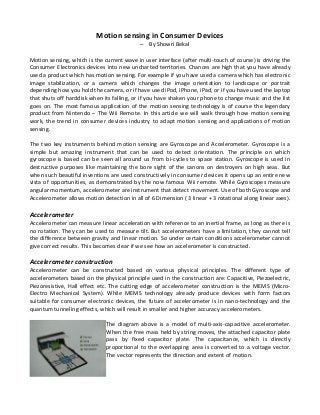
Motion Sensing_rev_0_02
- 1. Motion sensing in Consumer Devices – By Showri Bekal Motion sensing, which is the current wave in user interface (after multi-touch of course) is driving the Consumer Electronics devices into new uncharted territories. Chances are high that you have already used a product which has motion sensing. For example if you have used a camera which has electronic image stabilization, or a camera which changes the image orientation to landscape or portrait depending how you hold the camera, or if have used iPod, iPhone, iPad, or if you have used the laptop that shuts off harddisk when its falling, or if you have shaken your phone to change music and the list goes on. The most famous application of the motion sensing technology is of course the legendary product from Nintendo – The Wii Remote. In this article we will walk through how motion sensing work, the trend in consumer devices industry to adapt motion sensing and applications of motion sensing. The two key instruments behind motion sensing are Gyroscope and Accelerometer. Gyroscope is a simple but amazing instrument that can be used to detect orientation. The principle on which gyroscope is based can be seen all around us from bi-cycles to space station. Gyroscope is used in destructive purposes like maintaining the bore sight of the canons on destroyers on high seas. But when such beautiful inventions are used constructively in consumer devices it opens up an entire new vista of opportunities, as demonstrated by the now famous Wii remote. While Gyroscopes measure angular momentum, accelerometer are instrument that detect movement. Use of both Gyroscope and Accelerometer allows motion detection in all of 6 Dimension ( 3 linear + 3 rotational along linear axes). Accelerometer Accelerometer can measure linear acceleration with reference to an inertial frame, as long as there is no rotation. They can be used to measure tilt. But accelerometers have a limitation, they cannot tell the difference between gravity and linear motion. So under certain conditions accelerometer cannot give correct results. This becomes clear if we see how an accelerometer is constructed. Accelerometer construction Accelerometer can be constructed based on various physical principles. The different type of accelerometers based on the physical principle used in the construction are: Capacitive, Piezoelectric, Piezoresistive, Hall effect etc. The cutting edge of accelerometer construction is the MEMS (Micro- Electro Mechanical System). While MEMS technology already produce devices with form factors suitable for consumer electronic devices, the future of accelerometer is in nano-technology and the quantum tunneling effects, which will result in smaller and higher accuracy accelerometers. The diagram above is a model of multi-axis-capacitive accelerometer. When the free mass held by string moves, the attached capacitor plate pass by fixed capacitor plate. The capacitance, which is directly proportional to the overlapping area is converted to a voltage vector. The vector represents the direction and extent of motion.
- 2. Gyroscope While an accelerometer says I am accelerating at x m/s2 a gyroscope says I am rotating at x deg/sec. Gyroscopes measure all type of rotation including horizontal and their response is more than that of accelerometer. Their limitation being, able to respond only to rotation and not linear motion. Gyroscopes are constructed based on the principle of conservation of angular momentum. Once a gyroscope is set in motion its spin axis remains pointing in the same direction irrespective of the external torque applied. This principle is used to measure the changes in orientation of the gyroscope frame. Applications of Motion Sensing There are many products in market that are using accelerometers at the time of writing this article: Nitendo Wii, iPhone, iPod touch, Apple iPad, Google Nexus One, HTC Hero, Samsung Omnia, Samsung Omnia HD,Samsung Rogue (U960), Motorola Droid, Nokia N96, Nokia N97, Nokia 5800, Nokia N97 mini, Sony Ericsson W910i, Sony Ericsson C902, Palm Pre, Blackberry Storm, HTC Touch Diamond, HTC Dream,Microsoft Zune HD etc. The most imaginative use of the accelerometer, I think, is 'The Wand'. The wand, as the name suggest, looks like a wand, similar to one used by Harry Potter. Its capabilities are no lesser, a flick of the hand is all that requires to change the TV channel ! Few movements to increase decrease volume. Imaginative combination of accelerometers and wireless remote has really brought magic to life. But the best application of motion sensing in my opinion is the Google's SkyMap app for the Android phone. Just point your phone in any direction in the sky to display the name of the constellations, planets visible in that direction. Of course Pace is not behind in adaptation of motion sensing, our own Le- Cube has an accelerometer to detect whether the box is placed vertically or horizontally and adjust the LCD display accordingly Today Accelerometer has more adoption in Consumer Devices than Gyroscope. As we have seen each have their limitation. The trend is moving towards using both accelerometer and gyroscope to offset each others disadvantages. InvenSense – a company that produces MEMS bases gyroscope, is confident that in future gyroscope only system is feasible. While Texas Instruments, ST Microelectronics are pioneers in MEMS based accelerometers. InvenSense is a prominent player in MEMS based Gyroscopes. Accelerometers are available at less than $1 per axis while gyroscope from Invensense are available at $2 per axis. Form factor being almost same the price battle might finally decide which technology is used en-masse. Which ever way the technology take us motion sensing is here to stay and the user interface is up for complete revamp. Author Showri Prasad Bekal Project Parker / US Cable